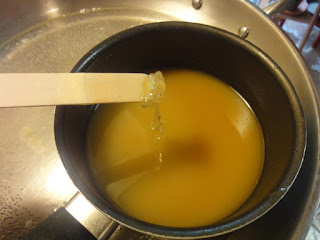A la Recherche de Cire Perdue (or, how to do the Lost Wax process)
I'm quite behind in these posts, so allow me to catch you up on our work from summer 2016 to now...
In order to cast pewter, we followed the lost-wax process, using plaster molds. Lost wax is an ancient process that goes back to perhaps the 3rd millennium BCE, with the oldest known examples coming from the Cave of the Treasure hoard in southern Israel. So if you're doing this work, you're in good company. (Here's a nice paper on the history of lost wax.)
You first make a wax object, either by casting wax into a mold or sculpting something in wax directly (which would require some artistic talent, so we skipped that.)
It's always a lovely sight and smell, mixing up beeswax in the kitchen.
Once you have your wax object, you have to make the plaster mold of it. Fix it well in a container, mix up your plaster, and pour.
Next, you need to burn that wax figure out of the mold, to create your void. Which is already something wonderful, if you think about it. Because first you make something soft and fragile and then you get rid of it to later produce something strong and solid. But you can't get to that strong and solid without it. Nor without the void - the right kind of emptiness. But I digress. (Or do I?)
We've tried different techniques to do the burnout - from a full-on blowtorch if the mold is open enough, to using a little impromptu firebrick kiln...
...to pulling out the trusty raku kiln to do a few molds at a time.
Wax burnout begun at 2:25 pm.
Temp between 155° C and 230° C for first 20 minutes.
Around 230° C for 20 mins; then up eventually to 335° C for 20 mins.
Dark smoke and stinky burnt smell once we hit 330° C.
Shut off at 3:30. Still smoking a lot at shut off. Maybe we shut off too early?
These are the first molds we have available for our entry into the Age of Metal. Coming soon (as soon as I type up the notes).
In order to cast pewter, we followed the lost-wax process, using plaster molds. Lost wax is an ancient process that goes back to perhaps the 3rd millennium BCE, with the oldest known examples coming from the Cave of the Treasure hoard in southern Israel. So if you're doing this work, you're in good company. (Here's a nice paper on the history of lost wax.)
You first make a wax object, either by casting wax into a mold or sculpting something in wax directly (which would require some artistic talent, so we skipped that.)
It's always a lovely sight and smell, mixing up beeswax in the kitchen.
 |
| I tossed a Venus back in the pot for remelting, and she started to glow. |
Once you have your wax object, you have to make the plaster mold of it. Fix it well in a container, mix up your plaster, and pour.
We've tried different techniques to do the burnout - from a full-on blowtorch if the mold is open enough, to using a little impromptu firebrick kiln...
...to pulling out the trusty raku kiln to do a few molds at a time.
Wax burnout begun at 2:25 pm.
Temp between 155° C and 230° C for first 20 minutes.
Around 230° C for 20 mins; then up eventually to 335° C for 20 mins.
Dark smoke and stinky burnt smell once we hit 330° C.
Shut off at 3:30. Still smoking a lot at shut off. Maybe we shut off too early?
These are the first molds we have available for our entry into the Age of Metal. Coming soon (as soon as I type up the notes).









Comments
Post a Comment